Overhead camshaft engine
An overhead camshaft (OHC) engine is a piston engine where the camshaft is located in the cylinder head above the combustion chamber.[1][2] This contrasts with earlier overhead valve engines (OHV), where the camshaft is located below the combustion chamber in the engine block.[3]
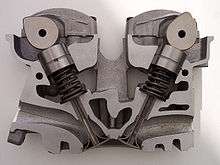
Single overhead camshaft (SOHC) engines have one camshaft per bank of cylinders. Dual Over Head Camshaft (DOHC, also known as "twin-cam.[4]") engines have two camshafts per bank. The first production car to use an DOHC engine was built in 1910. Use of DOHC engines slowly increased from the 1940s, leading to most automobiles by the early 2000s using DOHC engines.
Design
In an overhead camshaft engine, the camshaft is located at the top of the engine, above the combustion chamber. This contrasts the earlier overhead valve engine (OHV) and flathead engine configurations, where the camshaft is located down in the engine block. The valves in both OHC and OHV engines are located above the combustion chamber; however an OHV engine requires pushrods and rockers to transfer the motion from the camshaft up to the valves, whereas an OHC engine has the valves directly actuated by the camshaft.
Compared with OHV engines with the same number of valves, there are fewer reciprocating components in an OHC engine and there is less valvetrain inertia in an OHC engine, which reduces valve float at higher engine speeds (RPM).[1] A downside is that the system used to drive the camshaft (usually a timing chain in modern engines) is more complex in an OHC engine.
The other main advantage of OHC engines is that there is greater flexibility to optimise the size, location and shape of the intake and exhaust ports, since there are no pushrods that need to be avoided.[1] This improves the gas flow through the engine, increasing power output and fuel efficiency.
During engine repairs which require the removal of the cylinder head, a disadvantage of OHC engines is that the camshaft timing needs to be reset if the cylinder head is removed. In 1920-1940 Morris and Wolseley cars with OHC engines, oil leaks in the lubrication systems were also an issue.[5](pp15-18)
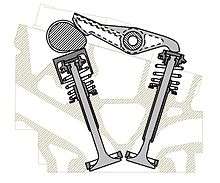
Single overhead camshaft
The oldest configuration of overhead camshaft engine is the single overhead camshaft (SOHC) design.[1][6] A SOHC engine has one camshaft per bank of cylinders, therefore a straight engine has a total of one camshaft. A V or flat engine with a total of two camshafts (one per bank of cylinders) is a single overhead camshaft engine, not a double overhead camshaft engine.
Regardless of number, the camshaft usually operates the valves indirectly via a rocker arm.[1][6]
Most SOHC engines have two valves per cylinder. However a few engines, such as the 1973 Triumph Dolomite Sprint engine and Honda J Series V6 Engine were an SOHC configuration with four valves per cylinder. This was achieved by the camshaft being located in the center of the cylinder head, with equal length rocker arms actuating the intake and exhaust valves.[7] This arrangement was used to provide four valves per cylinder while minimising the valvetrain mass and minimising the overall engine size.[8][9][10]
Double overhead camshaft
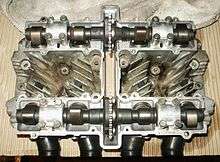
A double overhead camshaft (DOHC or "twin-cam") engine has two camshafts per bank of the cylinder head,[1][2][6] one for the intake valves and the other for the exhaust valves. Therefore there are two camshafts for a straight engine and a total of four camshafts for a V engine or a flat engine. Sometimes a DOHC V engine is marketed as a quad cam engine, however the "extra" two camshafts are a result of the engine's layout rather than providing a benefit compared with other DOHC engines. To further confuse the terminology, some SOHC flat-twin and V-twin engines (such as by Harley-Davidson, Riley Motors, Triumph and Indian) have been marketed by their manufacturers with the misleading term "twin-cam engine".
Most DOHC engines have four valves per cylinder, however DOHC engines with two valves per cylinder include the Alfa Romeo Twin Cam engine, the Jaguar XK6 engine, the early Ford I4 DOHC engine and the Lotus Ford Twin Cam engine.[6]
The camshaft usually operates the valves directly via a bucket tappet. A DOHC design permits a wider angle between intake and exhaust valves than in SOHC engines, which improves gas flow through the engine. A further benefit is that the spark plug can be placed at the optimum location, which in turn improves combustion efficiency.[6]
Components
Timing belt / timing chain
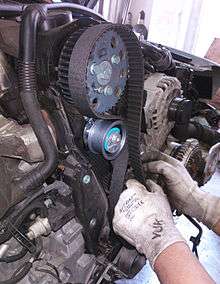
The rotation of the camshaft(s) are driven by the crankshaft. Many 21st century engines use a toothed timing belt made from rubber and kevlar to drive the camshaft.[1][6][11] Timing belts are inexpensive, produce minimal noise and have no need for lubrication.[12](p93) A disadvantage of timing belts is the need for regular replacement of the belt;[12](p94) recommended belt life typically varies between approximately 30,000–100,000 km (19,000–62,000 mi).[12](pp94-95)[13](p250)
The first known automotive application of timing belts to drive overhead camshafts was the 1953 Devin-Panhard racing specials built for the SCCA H-modified racing series in the United States.[14](p62) These engines were based on Panhard OHV flat-twin engines, which were converted to SOHC engines using components from Norton motorcycle engines.[14](p62) The first production car to use a timing belt was the 1962 Glas 1004 compact coupe.[15]
Another camshaft drive method commonly used on modern engines is a timing chain, constructed from one or two rows of metal roller chains.[1][6][11] By the early 1960s most production automobile overhead camshaft designs used chains to drive the camshaft(s).[5](p17) Timing chains do not usually require replacement at regular intervals, however the disadvantage is that they are noisier than timing belts.[13](p253)
Gear train
A gear train system between the crankshaft and the camshaft is commonly used in diesel overhead camshaft engines used in heavy trucks.[16] Gear trains are less commonly used in OHC engines for light trucks or automobiles.[1]
Other camshaft drive systems
Several OHC engines up until the 1950s used a shaft with bevel gears to drive the camshaft. Examples include the 1908-1911 Maudslay 25/30,[17][18] the Bentley 3 Litre,[19] the 1929-1932 MG Midget, the 1925-1948 Velocette K series,[20] the 1931-1957 Norton International and the 1947-1962 Norton Manx.[21] In more recent times, the 1950-1974 Ducati Single,[22] 1973-1980 Ducati L-twin engine, 1999-2007 Kawasaki W650 and 2011-2016 Kawasaki W800 motorcycle engines have used bevel shafts.[23][24] The Crosley four cylinder was the last automotive engine to use the shaft tower design to drive the camshaft, from 1946 to 1952; the rights to the Crosley engine format were bought by a few different companies, including General Tire in 1952, followed by Fageol in 1955, Crofton in 1959, Homelite in 1961, and Fisher Pierce in 1966, after Crosley closed the automotive factory doors, and they continued to produce the same engine for several more years.
A camshaft drive using three sets of cranks and rods in parallel was used in the 1920-1923 Leyland Eight luxury car built in the United Kingdom.[25][26][27] A similar system was used in the 1926-1930 Bentley Speed Six and the 1930-1932 Bentley 8 Litre.[27][28] A two-rod system with counterweights at both ends was used by many models of the 1958-1973 NSU Prinz.[5](p16-18)
History
1900-1914
Among the first overhead camshaft engines were the 1902 Maudslay SOHC engine built in the United Kingdom[18](p210)[5](p906)[29] and the 1903 Marr Auto Car SOHC engine built in the United States.[30][31] The first DOHC engine a Peugeot inline-four racing engine which powered the car that won the 1912 French Grand Prix. Another Peugeot with a DOHC engine won the 1913 French Grand Prix, followed by the Mercedes-Benz 18/100 GP with an SOHC engine winning the 1914 French Grand Prix.
The Isotta Fraschini Tipo KM— built in Italy from 1910-1914— was one of the first production cars to use an SOHC engine.[32]
World War I

During World War I, both the Allied and German air forces sought to quickly apply the overhead camshaft technology of motor racing engines to military aircraft engines. The SOHC engine from the Mercedes 18/100 GP car (which won the 1914 French Grand Prix) became the starting point for both Mercedes' and Rolls Royce's aircraft engines. Mercedes created a series of six-cylinder engines which culminated in the Mercedes D.III. Rolls Royce reversed-engineered the Mercedes cylinder head design based on a racing car left in England at the beginning of the war, leading to the Rolls-Royce Eagle V12 engine. Other SOHC designs included the Spanish Hispano-Suiza 8 V8 engine (with a fully enclosed-drivetrain), the American Liberty L-12 V12 engine and the German BMW IIIa straight-six engine. The DOHC Napier Lion W12 engine was built in Great Britain beginning in 1918.
Most of these engines used a shaft to transfer drive from the crankshaft up to the camshaft at the top of the engine. Large aircraft engines— particularly air-cooled engines— experienced considerable thermal expansion, causing the height of the cylinder block to vary during operating conditions. This expansion caused difficulties for pushrod engines, so an overhead camshaft engine using a shaft drive with sliding spline was the easiest way to allow for this expansion. These bevel shafts were usually in an external tube outside the block, and were known as "tower shafts".[33]
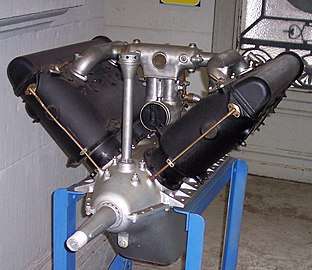 1914-1918 Hispano-Suiza 8A SOHC aircraft engine
1914-1918 Hispano-Suiza 8A SOHC aircraft engine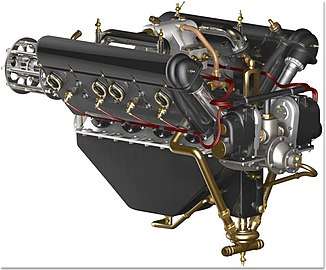 1914-1918 Hispano-Suiza 8Be SOHC aircraft engine with "tower shafts" at the rear of each cylinder bank
1914-1918 Hispano-Suiza 8Be SOHC aircraft engine with "tower shafts" at the rear of each cylinder bank
1919-1944
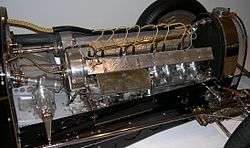
An early American overhead camshaft production engine was the SOHC straight-eight engine used in the 1921-1926 Duesenberg Model A luxury car.[34]
In 1926, the Sunbeam 3 litre Super Sports became the first production car to use a DOHC engine.[35][36]
In the United States, Duesenberg added DOHC engines (alongside their existing SOHC engines) with the 1928 release of the Duesenberg Model J, which was powered by a DOHC straight-eight engine. The 1931-1935 Stutz DV32 was another early American luxury car to use a DOHC engine. Also in the United States, the DOHC Offenhauser racing engine was introduced in 1933. This inline-four engine dominated North American open-wheel racing from 1934 until the 1970s.
Other early SOHC automotive engines were the 1920-1923 Wolseley Ten, the 1928-1931 MG 18/80, the 1926-1935 Singer Junior and the 1928-1929 Alfa Romeo 6C Sport. Early overhead camshaft motorcycles included the 1925-1949 Velocette K Series and the 1927-1939 Norton CS1.
1945-present
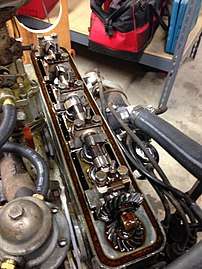
The 1946-1948 Crosley CC Four was arguably the first American mass-produced car to use an SOHC engine.[37][38][39] This small mass-production engine powered the winner of the 1950 12 Hours of Sebring.[37](p121)
Use of a DOHC configuration gradually increased after World War II, beginning with sports cars. Iconic DOHC engines of this period include the 1948-1959 Lagonda straight-six engine, the 1949–1992 Jaguar XK6 straight-six engine and the 1954-1994 Alfa Romeo Twin Cam inline-four engine.[40][41] The 1966-2000 Fiat Twin Cam inline-four engine was one of the first DOHC engines to use a toothed timing belt instead of a timing chain.[42]
In the 1980s, the need for increased performance while reducing fuel consumption and exhaust emissions saw increasing use of DOHC engines in mainstream vehicles, beginning with Japanese manufacturers.[40] By the mid-2000s, most automotive engines used a DOHC layout.
References
- Hillier, V.A.W. (2012) [First published 1966]. "2". Fundamentals of Motor Vehicle Technology (Academic text-book). Book 1. In association with: (IMI) (6th ed.). Nelson Thornes Ltd. ISBN 9781408515181.
- Stoakes, Graham; Sykes, Eric; Whittaker, Catherine (2011). "3". Principles of Light Vehicle maintenance & repair. Heinmann Work-Based Learning. Babcock International Group and Graham Stoakes. pp. 208–209. ISBN 9780435048167.
- "OHV, OHC, SOHC and DOHC (twin cam) engine - Automotive illustrated glossary". www.samarins.com. Retrieved 2018-09-20.
- Harley-Davidson Twin Cam engine, Fiat Twin Cam engine, Alfa Romeo Twin Cam engine, Quad 4 engine, Lotus-Ford Twin Cam
- Boddy, William (January 1964). "Random Thoughts About O.H.C." Motor Sport. London, UK: Teesdale Publishing. XL (1).CS1 maint: ref=harv (link)
- "SOHC vs DOHC Valvetrains: A Comparison". www.paultan.org. Driven Communications Sdn Bhd. 22 June 2005. Retrieved 29 August 2012.
- Heseltine, Richard (June 2010). Roebuck, Nigel (ed.). "Triumph Dolomite Sprint". Motor Sport. London, UK. 86 (6): 122. ISSN 0027-2019. Retrieved 29 March 2015.CS1 maint: ref=harv (link)
- Lewis, Jimmy (November 2001). Edwards, David (ed.). "New for '02: Honda CR250R CRF450R". Cycle World. Hachette-Filipacchi Magazines. 40 (11): 62. ISSN 0011-4286. Retrieved 2 January 2015.
- "How It Works: Honda Unicam® Engines". www.honda.com. 23 January 2013. Archived from the original on 22 February 2014. Retrieved 2 January 2015.
- "2010 Honda VFR1200A First Ride". www.moto123.com. 19 October 2009. Archived from the original on 2 January 2015. Retrieved 2 January 2015.
- "Dan's motorcycle 'Cam Drives'". www.dansmc.com. Retrieved 29 August 2012.
- Decker, John (June 1993). Oldham, Joe (ed.). "Saturday Mechanic: Replacing Your Timing Belt". Popular Mechanics. New York, NY US: Hearst. 170 (6). ISSN 0032-4558. Retrieved 1 March 2015.CS1 maint: ref=harv (link)
- Dorries, Elisabeth H. (2005). TechOne: Automotive Engine Repair. Clifton Park, NY US: Thompson Delmar Learning. ISBN 1-4018-5941-0. LCCN 2004057974. Retrieved 1 March 2015.CS1 maint: ref=harv (link)
- Pace, Harold W.; Brinker, Mark R. (2004). Vintage American Road Racing Cars 1950-1969. St. Paul MN US: MotorBooks International. p. 62. ISBN 0-7603-1783-6. Retrieved 27 February 2015.CS1 maint: ref=harv (link)
- Norbye, Jan P. (1984). "Expanding on Excellence: The 5-Series and 3-Series". BMW - Bavaria's Driving Machines. Skokie, IL: Publications International. p. 191. ISBN 0-517-42464-9.CS1 maint: ref=harv (link)
- Bennett, Sean (2014-01-01). Modern Diesel Technology: Diesel Engines. Stamford, CT US: Cengage Learning. pp. 88–89, 362. ISBN 978-1-285-44296-9. Retrieved 4 January 2015.
In most commercial diesels, OHCs are gear-driven.
- Boddy, William (August 1972). Boddy, William (ed.). "An Edwardian Overhead-Camshaft 25/30 Maudslay". Motor Sport. London, UK: Teesdale Publishing. XLVIII (8): 909. Archived from the original on 6 February 2015. Retrieved 6 February 2015.CS1 maint: ref=harv (link)
- Culshaw, David; Horrobin, Peter (2013) [1974]. "Maudslay". The Complete Catalogue of British Cars 1895 - 1975 (e-book ed.). Poundbury, Dorchester, UK: Veloce Publishing. p. 210. ISBN 978-1-845845-83-4.CS1 maint: ref=harv (link)
- Norbye, Jan P. (1981). The complete handbook of automotive power trains. Tab Books. p. 318. ISBN 0-8306-2069-9. LCCN 79026958. Retrieved 7 January 2015.
- Cameron, Kevin (March 2004). "TDC: Little things". Cycle World. 43 (3): 14. ISSN 0011-4286. Retrieved 7 January 2015.
- Wilson, Hugo (1995). "The A-Z of Motorcycles". The Encyclopedia of the Motorcycle. London, UK: Dorling Kindersley. p. 144. ISBN 0-7513-0206-6.CS1 maint: ref=harv (link)
- Walker, Mick (2003) [1991]. "4 Engine". Ducati Singles Restoration. St. Paul, MN US: Motorbooks International. p. 48. ISBN 0-7603-1734-8. Retrieved 4 January 2015.
- "2015 W800". www.kawasaki.eu. Retrieved 19 December 2019.
- Ash, Kevin (26 October 2011). "Kawasaki W800 review". The Telegraph. Archived from the original on 21 June 2013.CS1 maint: ref=harv (link)
- A US patent 1495620 A, John Godfrey Parry Thomas, "Internal Combustion Engine", issued 1924-05-27
- U.S. Patent 1,495,620
- Boddy, William (March 1974). Boddy, William (ed.). "How Did The Leyland Eight Rate?". Motor Sport. L (3): 230. Retrieved 3 January 2015.
- Brooks, Philip C. (2009). Carpenter, Rhonda; Iwalani, Kahikina (eds.). "The Mighty Sixes". The International Club for Rolls-Royce & Bentley Owners Desk Diary 2010. Tampa, FL USA: Faircount: 27, 32.CS1 maint: ref=harv (link)
- Georgano, G. N. (1982) [1968]. "Maudslay". In Georgano, G. N. (ed.). The New Encyclopedia of Motorcars 1885 to the Present (Third ed.). New York: E. P. Dutton. p. 407. ISBN 0525932542. LCCN 81-71857.
- "Marr Auto Car Company". www.marrautocar.com. Archived from the original on 11 April 2018.
- Kimes, Beverly Rae (2007). Walter L Marr: Buick's Amazing Engineer. Racemaker Press. p. 40. ISBN 978-0976668343.
- "1913 Isotta Fraschini 100-120 hp Tipo KM 4 Four-Seat Torpedo Tourer - Auction Lot". www.motorbase.com. Retrieved 29 December 2019.
- Thorpe, Leslie Aaron (1936). A text book on aviation: the new cadet system of ground school training. 3. Aviation Press. pp. 14–15. Retrieved 27 February 2015.
The overhead camshafts are driven by bevel gears and vertical shafts known as tower shafts.
CS1 maint: ref=harv (link) - Mueller, Mike (2006). "Chapter 6 - Chariot of the Gods Duesenberg Straight Eight". American Horsepower 100 Years of Great Car Engines. St. Paul, MN USA: Motorbooks. p. 51. ISBN 978-0-7603-2327-4. LCCN 2006017040. Retrieved 2015-02-02.
- "Talking of sports cars: Sunbeam three-litre". Autocar. 147 (nbr 4221): Pages 69–71. 1 October 1977.
- Georgano, G.N. (1985). Cars: Early and Vintage, 1886-1930. London: Grange-Universal.
- Simanaitis, Dennis (January 1994). Bryant, Thos L. (ed.). "Tech Tidbits". Road & Track. Newport Beach, CA US: Hachette Filipacchi Magazines. 45 (6): 121. ISSN 0035-7189.CS1 maint: ref=harv (link)
- "Crosley Engine Family Tree - Taylor Years". www.crosleyautoclub.com. Retrieved 19 December 2019.
- "Crosley Engine Family Tree - CoBra Years". www.crosleyautoclub.com. Retrieved 19 December 2019.
- "An Echo of the Past — the history and evolution of twin-cam engines". www.EuropeanCarWeb.com. European Car Magazine, Source Interlink Media. February 2009. Archived from the original on 3 March 2012. Retrieved 29 August 2012.
- "Technical- Boxer History". www.alfisti.co.uk. Archived from the original on 29 March 2013.
- "Old Fiat ad with Aurelio Lampredi". www.kinja-img.com. Retrieved 31 January 2015.